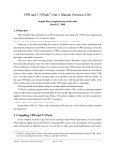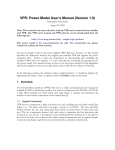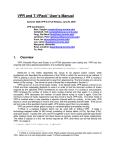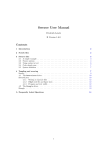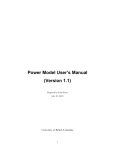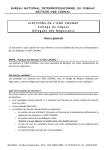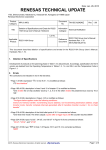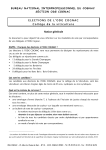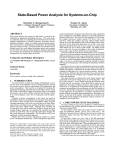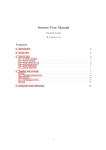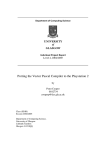Download VPR and VPA CK User`s Manual - Computer Engineering Research
Transcript
VPR and VPACK User’s Manual (Version 3.99a) October 3, 1999 1 (e.g. SPARC, HP, SGI, IBM, etc.). This ARCH_TYPE flag is only needed to determine which random ondly, change the ARCH_TYPE = SPARC line so that ARCH_TYPE is set to the name of your machine First, change the CC = gcc line in the makefile so that CC is set to the name of your desired compiler. Sec- and/or architecture are different, however, you will have to make some small modifications to the makefile. VPR simply by typing make in the directory containing VPR’s source code and makefile. If your compiler If your compiler of choice is gcc and you are running a Solaris-based Sparcstation, you can compile 2 Compiling VPR and VPACK line parameters. Typing either VPR or VPACK with no parameters will print out a list of all the available command vpack input.blif output.net [-options] VPR, and hence can be fed directly into VPR. Its usage is: together to form more coarse-grained logic blocks. The netlist it outputs is in the .net format required by netlist (in blif format) consisting of lookup tables (LUTs) and flip flops (FFs) and packs the LUTs and FFs VPACK is a packing program which can be used with or without VPR. It takes a technology-mapped VPR can perform either global routing or combined global and detailed routing. cuit will not route at the specified channel width, VPR simply report that it is unroutable. case, VPR places a circuit and attempts to route it only once, with the specified channel width. If the cir- exits. The other mode of VPR is invoked when a user specifies a specific channel width for routing. In this trying to route it again. Once the minimum number of tracks required to route the circuit is found, VPR each routing channel and tries again; if a routing is successful, VPR decreases the number of tracks before FPGA architecture to route this circuit. If a routing is unsuccessful, VPR increases the number of tracks in then repeatedly attempts to route it in order to find the minimum number of tracks required by the specified VPR can be run in one of two basic modes. In its default mode, VPR places a circuit on an FPGA and these files is described in Section 6. is read from placement.p. The final routing of a circuit is written to file routing.r. The format of each of final placement will be written to placement.p; if VPR is routing a previously placed circuit, the placement describes the architecture of the FPGA in which the circuit is to be realized. If VPR is placing a circuit, the Netlist.net is the netlist describing the circuit to be placed and/or routed, while architecture.arch vpr netlist.net architecture.arch placement.p routing.r [-options] many optional parameters; it is invoked by typing: VPR (Versatile Place and Route) is an FPGA placement and routing tool. VPR has four required and 1 Overview Vaughn Betz ([email protected]) October 3, 1999 VPR and VPACK User’s Manual (Version 3.99a) October 3, 1999 Figure 1: CAD flow. Placement and Routing Output Files, Placement and Routing Statistics Perform Either Global or Combined Global / Detailed Routing Place Circuit or Read in an Existing Placement VPR: .net Format Netlist of Logic Blocks VPACK: Pack FFs and LUTs into Logic Blocks VPR and VPACK User’s Manual (Version 3.99a) FPGA Architecture Description File Logic Block Parameters .blif Format Netlist of LUTs and Flip Flops Logic Optimization (SIS) Technology Map to LUTs (FlowMap) Circuit Existing Placement or Placement from Another CAD Tool 2 total wirelength, etc. In order to find the minimum number of tracks required for successful routing, VPR various statistics concerning the minimum number of tracks per channel required to successfully route, the VPR consists of a file describing the circuit placement, another file describing the circuit’s routing, and circuit and either globally route it or perform combined global and detailed routing on it. The output of grained logic blocks, and outputs a netlist in the .net format VPR uses. VPR [4, 5, 6] can then place the flip flops. Our VPACK program [3] then packs this netlist of 4-LUTs and flip flops into more coarse- into 4-LUTs and flip flops by FlowMap [2]. The output of FlowMap is a .blif format netlist of LUTs and form technology-independent logic optimization of each circuit. Next, each circuit is technology-mapped Figure 1 illustrates the CAD flow we typically use. First, the SIS [1] synthesis package is used to per- 3 Typical CAD Flow ifications to VPACK’s makefile. If you are using VPACK to convert SIS output to VPR’s netlist format, you should make similar mod- finds all the relevant libraries on your machine. level of optimization with your compiler, and it may be necessary to give the linker different options so it Finally, you may want to change the line FLAGS = -O2 to set FLAGS to the value that gives the highest number generator should be called by VPR, as not all machines have the same random number libraries. actually attempts to route the circuit several times with different numbers of tracks allowed per channel in N Figure 3: A cluster-based logic block. BLE #N N BLEs BLE #1 N Outputs cluster -no_clustering VPR and VPACK User’s Manual (Version 3.99a) October 3, 1999 Figure 2: Basic logic element. Clock D FF Out 3 VPR and VPACK User’s Manual (Version 3.99a) October 3, 1999 Number of distinct clocks in a logic cluster. 1 K-input LUT -clocks_per_cluster <int> Inputs 4* Number of distinct inputs in a logic cluster (i.e. I). cluster_size Number of BLEs in a cluster-based logic block (i.e. N). 1 -cluster_size <int> -inputs_per_cluster <int> Indicates whether clocks should be marked as being routed via a special, global resource. VPR does not route global signals. 4 Specifies that no clustering is to be performed -- i.e. the logic block consists of one BLE (a LUT and a FF) with no local routing. Number of inputs per LUT (i.e. K). Description inputs (KN, where K is the number of inputs per LUT), the local interconnect also allows each of the I on 4 -lut_size <int> -global_clocks {on | off} Default Option TABLE 1: VPACK Options. of interest unless you’re investigating CAD algorithms for clustering. options only affect the CAD algorithms employed to group BLEs into logic clusters, and are probably not three options are relevant only if VPACK is targeting a cluster-based logic block. Finally, the last two geting a single BLE-based logic block and when it is targeting a cluster-based logic block. The middle Table 1 lists all of VPACK’s options. The first three options are important both when VPACK is tar- block. The -clocks_per_cluster option is used to specify how many distinct clocks can be used by each logic The meaning of the -inputs_per_cluster and -cluster_size parameters should be clear from Figure 3. VPACK input.blif output.net -lut_size <K> -cluster_size <N> -inputs_per_cluster <I> -clocks_per_cluster <C> To target such a logic block, use a command line of the form: blocks used in the Altera 8K and 10K FPGAs, and to those used in the Xilinx 5200 series of FPGAs. inputs to be routed to any of the KN LUT inputs. Cluster-based logic blocks are very similar to the logic Clock I Inputs I ... back to LUT inputs. Since the number of logic block inputs, I, can be less than the total number of LUT ments (i.e. N LUTs and N FFs), along with local interconnect that allows the N cluster outputs to be routed logic block [3]. Figure 3 depicts an example. A cluster-based logic block consists of N basic logic ele- VPACK is capable of targeting a more complex form of logic block, which we call a cluster-based should specify -global_clocks off on the VPACK command line. most realistic thing to do. If, however, you want clocks to be routed as using normal routing resources, you should not route. Since clocks are typically routed via a dedicated network in FPGAs, this is usually the logic block inputs. By default, VPACK marks all clock nets in the input netlist as global nets which VPR logic block is a single basic logic element with no local routing to route the logic block output back to the not specified, a default LUT size of 4 is assumed by VPACK. The -no_clustering option indicates that the The -lut_size <K> option specifies the number of inputs to a LUT (i.e. K in Figure 2). If -lut_size is shown. names or numbers you are using, while unitalicized words are keywords and must be typed exactly as In the command above, the italicized values in angled brackets, <>, should be replaced by the file vpack <input.blif> <output.net> -lut_size <K> -no_clustering To have VPACK target a logic block of this form, use the command: element. consists of a LUT and a FF, in the configuration shown in Figure 2. We call this logic block a basic logic block to be targeted is selected via command-line options. The simplest logic block VPACK can target flops in .blif format, and outputs a .net format netlist composed of more complex logic blocks. The logic As stated earlier, VPACK takes as input a technology-mapped netlist of lookup tables (LUTs) and flip 4 Operation of VPACK route this pre-existing placement. placement produced by another CAD tool you can create a placement file in VPR format, and have VPR and describe the logic block in the FPGA architecture description file. Finally, if you want only to route a format. VPR can place and route netlists of any type of logic block -- you simply have to create the netlist by VPACK, your CAD flow can bypass VPACK altogether by outputting a netlist of logic blocks in .net .blif format and feed it into VPACK. Alternatively, if the logic block you are interested in is not supported technology mappers than SIS and FlowMap; just put the output netlist from your technology-mapper into Of course, many variations on this CAD flow are possible. One can use different logic optimizers and each attempted routing. ... VPR and VPACK User’s Manual (Version 3.99a) October 3, 1999 wrong side of a clb, your architecture description needs to be revised. 5 FPGA in the architecture description file -- if you see switches where they shouldn’t be or pins on the number. The routing resource view can be very useful in ensuring that you have correctly described your top of the drawing of the FPGA routing resources, and will label each of the pins on that block with its pin marked with an “X”. Clicking on a clb or pad will overlay the routing of all nets connected to that block on shown in green. The points at which wiring segments connect to clb pins (connection box switches) are tions from output pins to wiring segments are shown in red, and connections between wiring segments are and clb pins are drawn in black, connections from wiring segments to input pins are shown in blue, connec- RR will switch between various views of the routing resources available in the FPGA. Wiring segments visible or invisible, and clicking on a clb or pad will highlight their fanins and fanouts. Clicking on Toggle routed the true path of each net will be shown. Again, you can click on Toggle Nets to make net routings green, while its fanin and fanout are highlighted in blue and red, respectively. Once a circuit has been drawn from the net source to each of its sinks. Click on any clb in the display, and it will be highlighted in played, routing information is not yet known so nets are simply drawn as a “star;” that is, a straight line is The Toggle Nets button toggles the nets in the circuit visible/invisible. When a placement is being dis- graphics. greyed out to show they are not selectable when VPR is working, rather than interactively displaying next step in placing and routing the circuit, while Exit aborts the program. The menu buttons will be PostScript file (in pic1.ps, pic2.ps, etc.) of the image on screen. Proceed tells VPR to continue with the on the diagonally opposite corners of a box, to zoom in on a particular area. Selecting PostScript creates a the view, or click on the Zoom-In and Zoom-Out keys to zoom the view. Click on the Window button, then The graphics included in VPR are very easy to use. Click any mouse button on the arrow keys to pan 5.1 Graphics the four files used by VPR. This section outlines how VPR’s graphics and options work; Section 6 describes the format of each of vpr input.net input.arch placement.p output.routing [-options] Invoke VPR by typing: 5 Operation of VPR max_inputs Specifies the way in which the cluster packing algorithm picks the first BLE to be placed in an empty cluster. Max_sharing picks the BLE with the most signals in common with the last cluster, while max_inputs picks the BLE with the most used inputs. -cluster_seed {max_sharing | max_inputs} Controls whether the algorithm used to pack BLEs into clusters allows hill climbing or is strictly greedy. on -hill_climbing {on | off} Description Default TABLE 1: VPACK Options. Option The three options most people will be interested in are -fast, - -full_stats: Print out some extra statistics about the circuit and its routing useful for wireability analy- -ny <int>: Number of rows in the FPGA logic array. Default: set to minimum required to fit circuit. -nx <int>: Number of columns in the FPGA logic array. Default: set to minimum required to fit cir- VPR and VPACK User’s Manual (Version 3.99a) October 3, 1999 6 it leaves the highly-efficient automatic annealing schedule on and simply changes the number of moves per number of clbs. Changing inner_num is the best way to change the speed/quality tradeoff of the placer, as total number of blocks4/3 in the circuit. The number of blocks in a circuit is the number of pads plus the -inner_num <float>: The number of moves attempted at each temperature is inner_num times the -seed <int>: Sets the initial random seed used by the placer. Default: 1. user schedule, with a fixed initial temperature, final temperature and temperature update factor is used. ule is generally superior to any user-specified schedule. If any of init_t, exit_t or alpha_t is specified, the ment progresses, and uses them to determine how to update the temperature, when to exit, etc. This sched- By default, the automatic annealing schedule [6] is used. This schedule gathers statistics as the place- 5.2.2 Placer Options sis. Default: off. cuit. Default 1 (square FPGA). -aspect_ratio <float>: Specifies the aspect ratio (number of columns / number of rows) of an FPGA. -place_only: Place the circuit, but do not route it. Default: off. route it. Default: off. -route_only: Take an existing placement from the placement file specified on the command line and viewing the graphics. The higher the number, the more infrequently the program will pause. Default: 1. -auto <int>: Can be 0, 1, or 2. This sets how often you must click Proceed to continue execution after -nodisp: Disables all graphics. Useful if you're not running X Windows. Default: graphics enabled. quickly, at the cost of some (~10 - 15%) degradation in quality. -fast: Sets various placer and router parameters so that a circuit will be placed and routed more 5.2.1 General Options ble choices for an option. name or number. Values in curly braces separated by vertical bars, e.g. {on | off}, indicate all the permissi- In the following text, values in angle brackets, e.g. <int>, should be replaced by the appropriate file- www.eecg.toronto.edu/~vaughn). esoteric placer and router options actually do, download [4, 5] from the author’s web page (http:// ple looking at how different CAD algorithms perform will try many of them. To understand what the more route_chan_width, and -route_type. In general for the other options the defaults are fine, and only peo- VPR has a lot of options. To get a list of all the available options type vpr with no parameters. 5.2 Command-Line Options -initial_pres_fac <float>: Sets the starting value of the present overuse penalty factor. Default: 0.5. VPR and VPACK User’s Manual (Version 3.99a) October 3, 1999 VPR simply reports whether or not the circuit will route at this channel width. 7 search on channel capacity will be performed to find the minimum number of tracks required for routing -- -route_chan_width <int>: Tells VPR to route the circuit with a certain channel width. No binary routing should be performed. Default: detailed (i.e. combined global and detailed routing). -route_type {global | detailed}: Specifies whether global routing or combined global and detailed 5.2.3 Router Options Default: 4. an array of num_regions X num_regions subareas. Large values of num_regions greatly slow the placer. -num_regions <int>: Used only with the nonlinear cost function. VPR will compute congestion on attempts to map the circuit. the nonlinear cost is used, VPR will replace and reroute the circuit for each channel width at which it circuit only once, and repeatedly try routing the circuit as usual. If place_chan_width is not specified and a channel of relative width 1 is expected to need to complete routing of this circuit. VPR will then place the -place_chan_width <int>: Can be used with the nonlinear cost function to tell VPR how many tracks Default: 1. channel. Sets the exponent (α) used in the linear cost function to penalize routing in narrow channels. -place_cost_exp <float>: Only relevant for FPGAs in which the channel width varies from channel to ment. Default: linear. The nonlinear cost function, on the other hand, considers both wirelength and congestion during place- channels have the same width the linear cost function reduces to a bounding box wirelength cost function. -place_cost_type {linear | nonlinear}: Select the placement cost function. For FPGAs in which all than the locations of all blocks. Default: off (i.e. placer chooses pad locations). # Only needed if a clb VPR and VPACK User’s Manual (Version 3.99a) October 3, 1999 8 Each clb must have at least one subblock line, and can have up to N subblock lines, where N is the number Logic blocks (.clbs) also have to specify the internal contents of the logic block with subblock lines. reserved word open instead of a net name. If some pin of a clb is to be left unconnected, the corresponding entry in the pinlist should specify the file used for this run of VPR specifies. The first net listed in the pinlist connects to pin 0 of a clb, and so on. (.inputs and .outputs) have only one pin, while logic blocks (.clbs) have as many pins as the architecture and then lists the names of the nets connected to each pin of the logic block or pad. Input and output pads used to identify this block. The line immediately below this keyword line starts with the identifier pinlist: A circuit element is created by specifying a keyword at the start of a line, followed by the name to be element_type_keyword blockname pinlist: net_a net_b net_c ... subblock: subblock_name pin_num1 pin_num2 .. ified using the keywords .input, .output, and .clb, respectively. The format is shown below. Three different circuit elements are available: input pads, output pads, and logic blocks, and are spec- 6.1 Circuit Netlist (.net) Format continued on the line below. line is a comment, while a backslash (\) at the end of a line (and not in a comment) means that this line is In all the file format that follow, a sharp (#) character anywhere in a line indicates that the rest of the 6 File Formats if global routing is being performed, 0 if combined global/detailed routing is being performed. will be easier for a detailed router to subsequently route onto a segmented routing architecture. Default: 1 cost of some increase in track count. If only global routing is being performed, routes with fewer bends -bend_cost <float>: The cost of a bend. Larger numbers will lead to routes with fewer bends, at the Default: 3. file listing the desired location of each I/O block in the netlist (i.e. -fix_pins <file.pads>). This pad loca- tion file is in the same format as a normal placement file, but only specifies the locations of I/O pads, rather -bb_factor <int>: Sets the distance (in channels) outside of the bounding box of its pins a route can go. Larger numbers slow the router somewhat, but allow for a more exhaustive search of possible routes. ified, each I/O block is locked to a random pad location to model the effect of poor board-level I/O con- Default: 0.2. -acc_fac <float>: Specifies the accumulated overuse factor (historical congestion cost factor). plied after each router iteration. Default: 1.5. -pres_fac_mult <float>: Sets the growth factor by which the present overuse penalty factor is multi- track count. Values of 1000 or so are perfectly reasonable. Speed-quality trade-off: increase this number to speed up the router, at the cost of some increase in final straints. If any word other than random is specified after -fix_pins, that string is taken to be the name of a anneal. Instead, lock each I/O pad to some location at the start of the anneal. If -fix_pins random is spec- -fix_pins {random | <file.pads>}: Do not allow the placer to move the I/O locations about during the manual annealing schedule is enabled. Default: 0.8. -alpha_t <float>: The temperature is updated by multiplying the old temperature by alpha_t when the perature. Default: 0.01. -exit_t <float>: The (manual) anneal will terminate when the temperature drops below the exit tem- increase in final track count. This is most effective if -initial_pres_fac is simultaneously increased. may find this a more appropriate value of inner_num. 100. width. Default: 30. Speed-quality trade-off: reduce this number to speed up the router, at the cost of some reducing placement quality only by about 10%. Hence users more concerned with CPU time than quality -init_t <float>: The starting temperature of the anneal for the manual annealing schedule. Default: -max_router_iterations <int>: The number of iterations of a Pathfinder-based router that will be executed before a circuit is declared unrouteable (if it hasn’t routed successfully yet) at a given channel temperature. Default: 10. Note: specifying -inner_num 1 will speed up the placer by a factor of 10 while #Output pad. October 3, 1999 # Typical case: clock needn’t be routed, as there’s a # special network for it. VPR and VPACK User’s Manual (Version 3.99a) .global clk .input clk pinlist: clk .input c pinlist: c .input bpad pinlist: b .input a pinlist: a cluster-based logic block containing two clbs, however. 9 one BLE, which pins are hooked to this BLE is obvious. Consider a netlist in which each logic block is a In the netlist above the subblock line adds no new information -- since the logic block only contains .output out_and2 pinlist: and2 # 2 LUT inputs used, clock input unconnected. # Subblock line says the same thing. #Input pad. #Blocks can have the same name as nets with no conflict. .clb simple # Logic block. pinlist: a b open and2 open subblock: sb_one 0 1 open 3 open .input bpad pinlist: b .input a pinlist: a #This netlist describes a small circuit with two inputs #and one output. There is only one clb block, which is #a 3-input BLE (LUT+FF) that has one unconnected input. #This netlist assumes that the architecture input file defines #a clb as a 3-input BLE with pins 0, 1, and 2 being the LUT inputs, #pin 3 being the LUT output, and pin 4 being the BLE clock. An example netlist in which the logic block is a single BLE is given below. .global net_a net_b ... route these very high fanout signals (generally clocks). The syntax of the .global statement is: ered by the placement cost function or routed. It is assumed that some global routing resources exist to The only other keyword is .global. Use .global lines to specify that a net or nets should not be consid- the BLE output is assumed to be registered. pins total). If the subblock clock pin is “open” the BLE output is the unregistered LUT output; otherwise word open. The order of the BLE pins is: K LUT input pins, the BLE output, and the clock input (K + 2 BLE pin is connected. If a BLE pin is unconnected, the corresponding pin entry should be set to the key- subblock line first gives the name of the subblock, and then gives the number of the clb pin to which each input LUT (where K is set in the architecture description file) and a flip flop, as shown in Figure 2. The than N subblock lines, since some of the BLEs in the clb may be unused. Each subblock is a BLE -- a K- of BLEs (LUTs and FFs) in each logic block, as described by the architecture file. A clb may have less VPR and VPACK User’s Manual (Version 3.99a) October 3, 1999 10 from 0 to 1. Sets the distribution of tracks for the x-directed channels -- the channels that run horizontally. eted quantities are needed only for pulse, gaussian, and delta (which doesn’t need width). Most values are chan_width_x {gaussian | uniform | pulse | delta} peak <width> <xpeak> <dc>: The <> brack- channel. chan_width_io <float>: Width of the channels between the pads and core relative to the widest core FPGA must have the same width. be set to different relative widths. If detailed routing is to be performed, however, all the channels in the If global routing is to be performed, channels in different directions and in different parts of the FPGA can The next three keywords are used to describe the relative widths of the various channels in the FPGA. 6.2.1 Description of Relative Channel Widths in the FPGA This is the number of pads in each row or column of the FPGA. io_rat <int>: Sets the number of pads (inputs or outputs) that fit into the space occupied by one clb. following keywords must be specified in the architecture file. description below, strings between curly braces, {}, denote all the possible choices for an option. All of the Each line in an architecture file consists of a keyword followed by one or more parameters. In the 6.2 FPGA Architecture File (.arch) Format described in terms of subblock lines. the BLE structure is general enough that the timing behaviour of essentially arbitrary logic blocks can be block line. Note also that while the subblock lines describe the internal structure of a clb in terms of BLEs, lines for a clb, so if you are generating your own netlist you must make sure each clb lists at least one sub- analysis has not yet been added to VPR. However, the netlist parser will complain if there are no subblock -- information about the internal structure of a logic block is needed only for timing analysis, and timing to the logic block by local routing. Currently VPR does not actually make use of the subblock information In the netlist above, one needs the subblock statements to know what connections are made internally .output opad_2 pinlist: out_2 .output opad_1 pinlist: out_1 .clb more_complex pinlist: a b c open out_1 out_2 clk subblock: sb_one 0 1 open 4 open # BLE inputs are a and b, output # is out_1. Output isn’t registered. subblock: sb_two 0 1 2 5 6 # BLE inputs are a, b, and c, output # is out_2. The output is registered. # Example logic block: 4 inputs, 2 outputs, 1 clock. # Internally, the logic block contains two BLEs, # each of which consists of a 3-LUT and a FF. Fractional Distance across FPGA Figure 4: Specification of relative channel widths. dc uniform 0.5 1. VPR and VPACK User’s Manual (Version 3.99a) October 3, 1999 from the one channel bordering that pad. Hence no inpin or outpin statements are given for pads. 11 Pads are always assumed to have only one pin (either an input or an output), and this pin is accessible ing the clock pin. netlist file is the clock pin, your first pin statement in the architecture file must be an inpin statement defin- which your netlist (.net) file lists the connections to the clbs. For example, if the first pin on each clb in the NOTE: The order in which your inpin and outpin statements appear must be the same as the order in the same meanings as their counterparts in the inpin statement. outpin class: integer [top | bottom | left | right] [top | bottom | left | right] ...: All parameters have inputs of a LUT. Class numbers must start at zero and be consecutive. pin connection(s) is (are). All pins with the same class number are logically equivalent -- such as all the determines the class to which this pin belongs, and sets the side(s) of CLBs on which the physical output inpin class: integer [top | bottom | left | right] [top | bottom | left | right] ...: Declares an input pin, 6.2.2 Logic Block Description of tracks for the y-directed channels. chan_width_y [gaussian|uniform|pulse|delta] peak <width> <xpeak> <dc>: Sets the distribution fies that the horizontal channel in the middle of the FPGA is four times as wide as the other channels. specifies the width of all the other channels. For example, the statement chan_width_x delta 3 0.5 1 speci- channel -- it is the fractional distance across the FPGA at which this extra-wide channel lies. Finally, dc gle wide channel. Xpeak is between 0 and 1 and specifies the location within the FPGA of the extra-wide same width except one. The syntax is chan_width_x delta peak xpeak dc. Peak is the extra width of the sin- The delta function is used to specify a channel width distribution in which all the channels have the the standard deviation of the function. keyword, and they are all interpreted in exactly the same manner except that in the gaussian case width is (solid line) channel widths more clear. The gaussian keyword takes the same four parameters as the pulse between the pads and core. Figure 4 should make the specification of uniform (dashed line) and pulse and 1) sets the width of the x-directed core channels relative to the y-directed channels and the channels #2 Pads per row or column. #Same as core channels. #All same width # One BLE in each logic block # The LUT in a BLE has 4 inputs October 3, 1999 5 Inputs for use by BLEs first, then two #2 Pads per row or column. #Same as core channels. #All same width VPR and VPACK User’s Manual (Version 3.99a) # Logic block with 2 BLEs. # outputs, then the clock. io_rat 2 chan_width_io 1 chan_width_x uniform 1 chan_width_y uniform 1 # Uniform channel architecture, cluster-based logic block containing # 2 BLEs. puts, clock. 12 was created with VPACK, the pin ordering we need to match the .net file is: inputs for use by BLEs, out- block contains two separate BLEs, and each BLE consists of a 4-input LUT and a flip flop. If the .net file block, where each logic block has 5 inputs for use by its BLEs, 2 outputs and one clock input. Each logic As a second example of an architecture file, consider a logic block consisting of a cluster-based logic subblocks_per_cluster 1 subblock_lut_size 4 # Class 0 is LUT inputs, class 1 is the output, class 2 is the clock # in this case. # 4-input LUT. LUT inputs first, then output, then clock. inpin class: 0 bottom top #Physical pins at both top and bottom of clb. inpin class: 0 left right inpin class: 0 bottom top inpin class: 0 left right outpin class: 1 top bottom inpin class: 2 bottom top io_rat 2 chan_width_io 1 chan_width_x uniform 1 chan_width_y uniform 1 # Uniform channel architecture, 4-input LUT and a FF (one BLE) per clb. nets to any one of them. Notice also that pins can be physically accessible from several sides. inputs all have the same pin class, indicating that they are logically equivalent and the router may connect input pins are listed first, followed by the clb output pin, followed by the clock pin. Notice that the four produced by VPACK with the -no_clustering option. This clb contains a 4-input LUT and a flip flop; the The listing below is for an FPGA with all channels of the same width, and a clb compatible with that examples below illustrates. it is possible to describe the timing relations between inputs and outputs in terms of BLEs, as one of the this information is only needed for timing analysis. Even if your logic block is not constructed from BLEs, subblock_lut_size <int>: The number of LUT inputs to each of the subblock BLEs (i.e. K). Again, must specify a value for this parameter or the parser will complain. width subblocks_per_cluster <int>: Specifies the maximum number of BLEs in each logic block. This information is needed only for timing analysis, which is not yet incorporated into VPR. Nonetheless, you peak xpeak is pulse midpoint pulse If uniform is specified, you simply specify one argument, peak. This value (by convention between 0 0. Relative Channel Width 1. #Output 1 #Output 2 #Clock simply hit the “Toggle RR” button when a completed routing is on screen in VPR. In general the wilton switch box is the best of these three topologies and leads to the most routable FPGAs. ent class, say class 2 and class 3. in5 in4 in1 in2 in3 out2 out1 VPR and VPACK User’s Manual (Version 3.99a) October 3, 1999 Figure 5: Example logic block where many pins are not logically equivalent. subblocks_per_cluster 2 subblock_lut_size 3 each BLE having 3 inputs. 13 depends only on in4 and in5. Therefore we could model this logic block as consisting of two BLEs, with relationship between the inputs and outputs. Clearly out1 depends only on in1, in2 and in3, while out2 If we want to perform timing analysis on the logic block of Figure 5, we must describe the timing VPR and VPACK User’s Manual (Version 3.99a) October 3, 1999 14 placement. This information is used to ensure you are warned if you accidentally route this placement The first line of the placement file lists the netlist (.net) and architecture (.arch) files used to create this 6.3 Placement File Format: switch_block_type wilton # generally the most routable switch box topology Fc_type fractional # Fc values below are in terms of fraction of W. Fc_output 1. # clb output pins connect to all W tracks in adjacent channels. Fc_input 0.5 # clb input pins connect to half (0.5 * W) of adjacent tracks. Fc_pad 0.7 # I/O pads connect to 70% (0.7 * W) of adjacent tracks. The lines below give an example of a detailed routing description from a .arch file. the pad. Fc_pad <float>: Sets the number of tracks to which each I/O pad connects in the channel bordering channel bordering the pin. Fc_output <float>: Sets the number of tracks to which each logic block output pin connects in each width, W, so you can set Fc to be huge if you want Fc to always be W. channel bordering the pin. The Fc value used is always the minimum of the specified Fc and the channel Fc_input <float>: Sets the number of tracks to which each logic block input pin connects in each channel to which each pin connects (fractional). interpreted as the number of tracks to which each pin connects (absolute), or the fraction of tracks in a Fc_type {absolute | fractional}: Indicates whether the three Fc [7] values (see below) should be described in [8], while the universal switch box is described in [9]. To see the topology of a switch box, and could be made class 1. Out1 and out2 are obviously not logically equivalent, so each must be a differ- #in1 #in2 #in3 #in4 #in5 #out1 #out2 ment in track 0 can only connect to other wire segments in track 0 and so on. The wilton switch box is is logically equivalent, and could all be made class 0. Similarly, the set {in4, in5} is logically equivalent, top left right bottom right left top subset switch box is the planar or domain-based switch box used in the Xilinx 4000 FPGAs -- a wire seg- in Figure 5, which consists of a 3-input and gate and a 2-input or gate. In this case, the set {in1, in2, in3} inpin class: 0 inpin class: 0 inpin class: 0 inpin class: 1 inpin class: 1 outpin class: 2 outpin class: 3 ments. The exact topology of which wire segment connects to which can be one of three choices. The logic blocks, as the local routing within the block provides full connectivity. However, for most logic blocks all the inputs and all the outputs are not logically equivalent. For example, consider the logic block switch_block_type {subset | wilton | universal}: All the switch blocks [7] have Fs = 3. That is, whenever horizontal and vertical channels intersect, each wire segment can connect to three other wire seg- only when all channels have been specified to have the same width. bal/detailed routing is to be performed. Note that currently combined global/detailed routing is possible The following information is only required to be in the architecture description file if combined glo- 6.2.3 Detailed Routing Architecture Description outputs are of the same class, indicating they are also logically equivalent. This is true of all cluster-based # Two BLEs in each logic block # The LUT in a BLE has 4 inputs One line of a .net file of a circuit made out of such logic blocks might therefore be: .clb block_1 pinlist: in1 in2 in3 in4 in5 out1 out2 subblock: and_gate 0 1 2 5 open # out1 depends on in1, in2 and in3, # and is not registered. subblock: or_gate 3 4 open 6 open # out2 depends on in4 and in5 # and is not registered. Notice that all the inputs are of the same class, indicating they are all logically equivalent, and all the subblocks_per_cluster 2 subblock_lut_size 4 # Class 0 is LUT inputs, class 1 is the output, class 2 is the clock # in this case. inpin class: 0 bottom inpin class: 0 left inpin class: 0 right inpin class: 0 top inpin class: 0 bottom outpin class: 1 top bottom outpin class: 1 left right inpin class: 2 bottom top x y subblock_number x -0 1 0 1 1 0 1 1 y -1 0 2 3 3 2 2 1 subblk -----0 0 1 0 1 0 0 0 block number -----------#0 -- NB: block number is a comment. #1 #2 #3 #4 #5 #6 #7 Chany (0,1) Pad (0,1) Pad (2,0) Pad (1,0) Clb (2,1) Chanx (2,0) Chany (1,1) Chanx (2,1) Clb (2,2) Chanx (1,0) Clb (1,1) Chanx (1,1) Clb (1,2) Chanx (2,2) Chanx (1,2) Chany (2,1) Chany (2,2) VPR and VPACK User’s Manual (Version 3.99a) October 3, 1999 Figure 6: Coordinate system used by VPR. Chany (0,2) Pad (0,2) Pad (2,3) Pad (1,3) Chany (1,2) Pad (3,1) Pad (3,2) 15 1. VPR and VPACK User’s Manual (Version 3.99a) Net 5 (xor5) is listed below. October 3, 1999 16 that you do not count the same segment several times by ignoring this fact. An example routing for one net a SINK is the connection into the already specified routing tree; when computing routing statistics be sure part of the existing routing to which the new path attaches. It is important to realize that the first pin after will always go from a SOURCE to a SINK. The routing segment listed immediately after the SINK is the For an N-pin net, we need N-1 distinct wiring “paths” to connect all the pins. The first wiring path the various nets. CHANX and CHANY resources listed in the routing will be 0, as global routing does not assign tracks to 0 is the leftmost track. Note that if only global routing was performed the track number for each of the horizontal channel (CHANX) track 0 is the bottommost track, while in a vertical channel (CHANY) track location (x, y) we are attached. See Figure 6 for a diagram of the coordinate system used by VPR. In a are attaching to a pad, the pad number given for a resource is the subblock number defining to which pad at whichever one is appropriate. The meaning of these numbers should be fairly obvious in each case. If we number (if the SOURCE or SINK was on a clb) or track number (for CHANX or CHANY) is listed -- SOURCE, SINK, IPIN or OPIN was on an I/O pad), pin number (if the IPIN or OPIN was on a clb), class brackets after the keyword is the (x, y) location of this routing resource. Finally, the pad number (if the channel), and CHANY (vertical channel). Each routing begins on a SOURCE and ends on a SINK. In SINK (the sink of a certain input pin class), OPIN (output pin), IPIN (input pin), CHANX (horizontal type of routing segment. The possible keywords are SOURCE (the source of a certain output pin class), and nx and y between 1 and ny, inclusive. All pads either have x equal to 0 or nx + 1 or y equal to 0 or ny + An example placement file is given below. the net index used internally by VPR to identify the net and, in brackets, the name of the net given in the netlist file. The following lines define the routing of the net. Each begins with a keyword that identifies a in the x and y directions are denoted by nx and ny, respectively. Clbs all go in the area with x between 1 global or the detailed routing for each net, one by one. Each routing begins with the word net, followed by The first line of the routing file gives the array size, nx x ny. The remainder of the routing file lists the 6.4 Routing File Format unlike the old version. Note that this new version of VPR allows the blocks in a placement file to be listed in any order, #block name #---------a b c d e out:xor5 xor5 [1] Netlist file: xor5.net Architecture file: sample.arch Array size: 2 x 2 logic blocks Figure 6 shows the coordinate system used by VPR via a small 2 x 2 clb FPGA. The number of clbs ifying VPR and trying to debug something. is the internal index used by VPR to identify a block -- it may be useful to know this index if you are mod- The placement files output by VPR also include (as a comment) a fifth field: the block number. This be zero. For clbs, the subblock number is always zero. subblock numbers -- i.e. if only one pad at (x, y) is used, the subblock number of the I/O placed there will contains this pad. Note that the first pads occupied at some (x, y) location are always those with the lowest ture file, the subblock number specifies which of the several possible pad locations in row x and column y we can have more than one pad in a row or column when io_rat is set to be greater than 1 in the architec- umn in which the block is placed, respectively. The subblock number is meaningful only for pads. Since The block name is the name of this block, as given in the input netlist. X and y are the row and col- block_name All the following lines have the format: array used by this placement. with a different architecture or netlist file later. The second line of the file gives the size of the logic block (1,2) (1,2) (1,1) (2,1) (2,2) (2,2) (1,1) (1,2) (2,2) (1,2) (1,3) (1,3) Class: Pin: 4 Track: Track: Pin: 0 Class: Track: Track: Track: Track: Pad: 1 Pad: 1 V. Betz and J. Rose, “On Biased and Non-Uniform Global Routing Architectures and CAD Tools for FPGAs,” CSRI Technical Report #358, Department of Electrical and Computer Engineering, University of Toronto, 1996. (Available for download from http://www.eecg.toronto.edu/~vaughn/ papers/techrep.ps.Z). [5] VPR and VPACK User’s Manual (Version 3.99a) October 3, 1999 describing the entire routing resource graph, call the dump_rr_graph subroutine. 17 graph describing your FPGA, you should be able to route your FPGA. If you want to read a text file tions between them. If you change the routines that build this graph (in rr_graph.c) so that they create a only with a graph that defines all the available routing resources in the FPGA and the permissible connec- tecture description file, don’t despair! The router, graphics, sanity checker, and statistics routines all work Finally, if you need to route an FPGA whose routing architecture cannot be described in VPR’s archi- of the router. and the placer, respectively. I generate and print out a routing serial number to allow easy regression testing The initial and final placement costs provide useful numbers for regression testing the netlist parsers may want to redirect screen output to a file. pr.h, a great deal of intermediate data will be printed to the screen as VPR runs. If you set verbose, you major sanity checks are always enabled, regardless of the state of DEBUG. Finally, if VERBOSE is set in formed during a run. I normally leave DEBUG on all the time, as it only slows execution by 1 to 2%. The you expect. If the preprocessor flag DEBUG is defined in pr.h, some additional sanity checks are per- into net.echo and arch.echo. These files can be examined to be sure that VPR is parsing the input files as After parsing the netlist and architecture files, VPR dumps out an image of its internal data structures 7 Debugging Aids Net 146 (pclk): global net connecting: Block pclk (#146) at (1, 0), pinclass -1. Block pksi_17_ (#431) at (3, 26), pinclass 2. Block pksi_185_ (#432) at (5, 48), pinclass 2. Block n_n2879 (#433) at (49, 23), pinclass 2. for a global net is given below. always -1; since pads do not have logically-equivalent pins, pin classes are not needed. An example listing is simply whatever class was specified for that pin in the architecture input file. For pads the pinclass is block and the class of the pin to which the net must connect at each block is also printed. For clbs, the class of the blocks (name and internal index) which this net must connect is printed out. The location of each 18 Y. W. Chang, D. F. Wong, and C. K. Wong, “Universal Switch Modules for FPGA Design,” ACM Trans. on Design Automation of Electronic Systems, Jan. 1996, pp. 80 - 101. [9] October 3, 1999 S. Wilton, “Architectures and Algorithms for Field-Programmable Gate Arrays with Embedded Memories,” Ph.D. Dissertation, University of Toronto, 1997. (Available for download from http:// www.eecg.toronto.edu/~wilton/papers/postscripts/thesis.ps.gz). [8] VPR and VPACK User’s Manual (Version 3.99a) S. Brown, R. Francis, J. Rose, and Z. Vranesic, Field-Programmable Gate Arrays, Kluwer Academic Publishers, 1992. [7] V. Betz and J. Rose, “VPR: A New Packing, Placement and Routing Tool for FPGA Research,” Submitted to the Seventh Annual Workshop on Field Programmable Logic, 1997. V. Betz and J. Rose, “Directional Bias and Non-Uniformity in FPGA Global Routing Architectures,” ICCAD, 1996, pp. 652 - 659. [4] [6] V. Betz and J. Rose, “Cluster-Based Logic Blocks for FPGAs: Area-Efficiency vs. Input Sharing and Size,” To appear in CICC, 1997. [3] # This sink is an output pad at (1,3), subblock 1. J. Cong and Y. Ding, “FlowMap: An Optimal Technology Mapping Algorithm for Delay Optimization in Lookup-Table Based FPGA Designs,” IEEE Trans. CAD, Jan. 1994, pp. 1 - 12. [2] 0 1 1 1 1 # Sink for pins of class 0 on a clb. # Note: Connection to existing routing! E. M. Sentovich et al, “SIS: A System for Sequential Circuit Analysis,” Tech. Report No. UCB/ERL M92/41, University of California, Berkeley, 1992. 8 References [1] # Source for pins of class 1. 1 1 1 Nets which are specified to be global in the netlist file (generally clocks) are not routed. Instead, a list SOURCE OPIN CHANX CHANX IPIN SINK CHANX CHANY CHANX CHANX IPIN SINK









